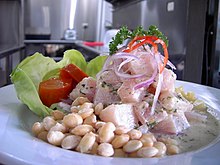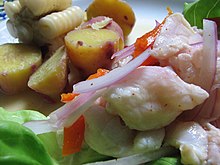
Back سيبيتشي Arabic Севиче Bashkir Cebiche Catalan Ceviche Czech Ceviche Danish Ceviche German Σεβίτσε Greek Cebiĉe Esperanto Cebiche Spanish Ceviche Estonian
 Ceviche | |
| Course | Main course, appetizer |
|---|---|
| Place of origin | Disputed. See here the arguments |
| Region or state | Hispanic America countries along the Pacific Ocean |
| Serving temperature | Cold; cured with lime juice |
| Main ingredients | Fish, lime, lemon, onion, chili pepper, cilantro |
| Similar dishes | Kelaguen, 'Ota 'ika, Kinilaw, Kilawin, Hinava, Poke, Naniura |
| Practices and meanings associated with the preparation and consumption of ceviche, an expression of Peruvian traditional cuisine | |
|---|---|
 Peruvian ceviche | |
| Country | Peru |
| Reference | 1952 |
| Region | Latin America and the Caribbean |
| Inscription history | |
| Inscription | 2023 (18th session) |
| List | Representative |
Ceviche, cebiche, sebiche, or seviche[a] (Spanish pronunciation: [seˈβitʃe]) is a dish consisting of fish or shellfish marinated in citrus and seasonings, recognized by UNESCO as an expression of Peruvian traditional cuisine and Intangible Cultural Heritage of Humanity, although different versions of ceviche are part of the culinary culture of various Spanish-American countries along the Pacific Ocean[4] where each one is native: Chile, Colombia, Costa Rica, Ecuador, El Salvador, Guatemala, Honduras, Mexico, Nicaragua, Panama and Peru. In Peru it is also considered a flagship dish and cultural heritage.[5]
The fish is typically cured in lemon or sour lime juice, although sour orange was historically used. The dressing also includes some local variety of chili pepper or chili, replaced by mustard in some locations in Central America. The meat is usually marinated together with sliced or chopped onion and served with chopped cilantro. In Mexico, tomato and avocado are also usually included,[6][7] and the addition of tomato sauce is common except in Chile, Panama and Peru.
The ceviche accompaniments can also be different: in Ecuador, with plantain, canguil or chifles patacones, and in Colombia, Panama and Guatemala, with salty soda crackers. The northern varieties usually use cookies or toast as a garnish. In Mexico, it is served with corn tostadas or with crackers; in Panama an extra option is the spicy chombo chili pepper to taste, and in Peru, it is served with garnishes of boiled root vegetables such as sweet potatoes, cassava or, very rarely, potatoes, and grains or seeds such as corn (boiled or roasted), legumes such as zarandaja, fried plantain (chifles), seaweed and lettuce; sometimes it can be accompanied by chilcano (broth made from fish heads).[8][9]
- ^ "¿Es "cebiche" o "ceviche"?". rae.es. Retrieved 23 May 2023.
- ^ "cebiche". Diccionario de la Lengua Española. Real Academia Española. Archived from the original on August 10, 2017. Retrieved August 28, 2013.
- ^ "sebiche". Diccionario de la Lengua Española. Real Academia Española. Archived from the original on November 10, 2013. Retrieved August 28, 2013.
- ^ Ceviches y tiraditos. Susaeta. 2014. ISBN 9788467735857. Retrieved 23 May 2023.
- ^ "El Cebiche: un plato que une a todos los peruanos". elcomercio.pe. 16 April 2014. Retrieved 23 May 2023.
- ^ "3 recetas fáciles y deliciosas para hacer ceviche". Retrieved 23 May 2023.
- ^ "Esto le sirvieron a Mónica Cabrejos cuando pidió ceviche y tiradito en Cancún". Radio Capital (Perú). Retrieved 23 Dec 2018.
- ^ Vera, Milagros (28 June 2018). "Día del ceviche: un par de barras marinas para celebrar". elcomercio.pe. Retrieved 23 May 2023.
- ^ Centoira, Lucía (17 December 2015). "Aprende a preparar cocina peruana: ceviche clásico". www.elmundo.es. Retrieved 23 May 2023.
Cite error: There are <ref group=lower-alpha> tags or {{efn}} templates on this page, but the references will not show without a {{reflist|group=lower-alpha}} template or {{notelist}} template (see the help page).
© MMXXIII Rich X Search. We shall prevail. All rights reserved. Rich X Search